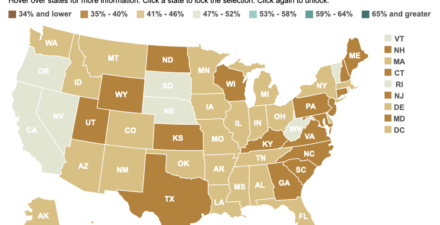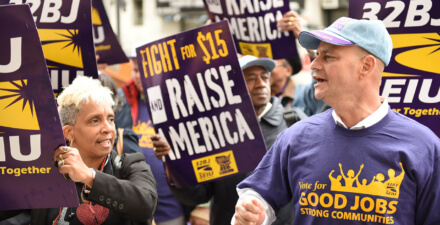Rebuilding U.S. labor market wage standards

This essay is part of Vision 2020: Evidence for a stronger economy, a compilation of 21 essays presenting innovative, evidence-based, and concrete ideas to shape the 2020 policy debate. The authors in the new book include preeminent economists, political scientists, and sociologists who use cutting-edge research methods to answer some of the thorniest economic questions facing policymakers today.
To read more about the Vision 2020 book and download the full collection of essays, click here.
Overview
Over the past 40 years, the United States has experienced a sustained rise in wage and income inequality. This high level of inequality reflects both a disconnect between average wages and productivity and between top and bottom wages, with much of the growth in labor productivity accruing to wages at the top of the distribution.
The results: a growing gap between median compensation and average productivity and between the capital and labor shares of national income. While net productivity grew by 72 percent between 1973 and 2014, median real compensation grew only by 8 percent over that same period. (See Figure 1.)
Figure 1

Much of the gap between mean productivity and median compensation arises from growing inequality in the labor market, which has risen steadily over this period and especially since 1980. This is evident because mean compensation grew by around 43 percent over this period, versus 9 percent for the median. Further underscoring this dynamic, real wage growth for those at the 90th percentile of income was more than 35 percent between 1973 and 2016, compared to 6 percent real wage growth for median income earners and the bottom 10th percentile.
Globalization and technological change have likely played a role in these growing income inequality trends, but a sizable body of evidence in economics suggests institutions have been important contributors to these trends as well—including collective bargaining and statutory minimum wages. The stagnation of the federal minimum wage since 1980 contributed to real wage declines at the bottom of the income distribution.1 And the erosion of collective bargaining led to wage declines for middle-income workers.2
This essay first examines the evidence demonstrating that raising the federal minimum wage boosts the incomes of those workers at the bottom of the income distribution without any significant job losses for those workers. I then present the case for establishing so-called wage boards in the United States, akin to those now in place in Australia, where they set minimum pay standards by industry and occupation. Indeed, the legal infrastructure for wage boards in the United States is in place in several states already and could be emulated or expanded upon by policymakers.
If federal policymakers are interested in raising the pretax earnings for American workers in our nation, then these are important arrows in our policy quiver. As I detail below, raising the federal minimum wage (and indexing it to the median wage) is an obvious starting point. Going beyond just raising the minimum wage, policymakers should also consider wage boards, which could also raise wages for the typical U.S. middle-income worker.
Raising the federal minimum wage
Between 1938 and 1968, wages throughout the wage distribution were generally growing together, and the minimum wage also kept up with the wages of most other workers in the U.S. economy. The high-water mark for the minimum wage was in 1968, when it reached $10.50 an hour in 2019 dollars. The minimum wage then began to decouple from both productivity and even the median wage starting around 1980, reaching a historic low of $6.63 an hour in 2006 (in 2019 dollars) and today stands at $7.25 per hour.
Consider also the shrinking size of the federal minimum wage compared to the median wage of full-time workers. This ratio (sometimes called the Kaitz index) reached a high of 55 percent in the United States in 1968. Today, it is around 35 percent, one of the lowest in the developed world. The stagnant federal minimum wage has led 29 states to raise their minimum wages above the federal standard. Yet for a large share of the U.S. workforce, the federal minimum is the only standard in effect—and this standard is at an all-time low in both historical and comparative terms.
A substantial increase in the federal minimum wage is an important lever for raising pretax earnings for those workers at the bottom of the pay distribution.
Are there unintended consequences of raising the minimum wage?
Minimum wages raise the pay of workers at the bottom of the income distribution, but one concern is that a higher minimum wage also may lead employers to cut back on hiring. There is a large and sometimes contentious literature that has looked at this question with varying conclusions.3 In my assessment, the overall weight of recent research strongly supports the view that the minimum wage increases of the magnitude we have seen in the United States in recent years generate only modest employment effects.
In their 2014 book What Does the Minimum Wage Do?, economists Dale Belman at Michigan State University and Paul J. Wolfson at Dartmouth College’s Tuck School of Business review a large body of literature, and conclude that it was unlikely that the minimum wage increases under study led to substantial job losses. A similar conclusion was reached by other economists doing formal meta analysis, a well-defined statistical approach of pooling the results from a large number of separate analyses. And a meta analysis conducted by economists Hristos Doucouliagos at Deakin University and T.D. Stanley at Hendrix College, along with one released in 2015 by Belman and Wolfson, also concludes that the overall impact of minimum wages on employment is small.4
While meta analyses are helpful in summarizing the overall state of the literature, not all studies are created equal. This is why policymakers and economists alike should put more weight on high-quality evidence. In a paper I co-authored that was recently published in the Quarterly Journal of Economics, we provide arguably the most complete picture to date of how minimum wages impact low-wage jobs.5 The basic idea is simple. Imagine the minimum wage rises from $9 to $10 an hour in Nebraska. Clearly, there will be fewer jobs paying less than $9 per hour in Nebraska after the policy is enacted. Some of those jobs that would have paid less than $9 are now simply paying $9 or a bit more; other jobs may be destroyed if the costs exceed benefits to employers.
By comparing how many fewer jobs paying less than $9 there are due to the policy to how many additional jobs are paying $9 or slightly more, we can infer the total change in low-wage jobs caused by the minimum wage policy change. Of course, it’s possible that wages would have risen even absent the policy change in Nebraska; to account for that, we compare the changes in sub-$9 jobs and above-$9 jobs in Nebraska to the same in other states that did not raise the minimum wage. Finally, we pool across 138 prominent minimum wage changes instituted between 1979 and 2016 across various states. The following figure summarizes our key findings. (See Figure 2.)
Figure 2

Figure 2 shows the effect of an average minimum wage increase on the wage distribution at each wage level relative to the minimum wage. As we would expect, minimum wage increases led to a clear reduction in jobs paying less than the new minimum wage, confirming employers are abiding by the law. Yet the reduction in jobs paying less than the minimum was balanced by a sharp increase in the number of jobs paying at the new minimum, along with additional increases in jobs paying up to $5 more than the new minimum.
As Figure 2 also shows, my co-authors and I found virtually no change in employment higher up in the wage distribution. Overall, then, low-wage workers saw a wage gain of 7 percent after a minimum wage increase, but little change in employment over the 5 years following implementation.
Our research also shows why methods used in some of the previous studies are more susceptible to biases resulting from shocks to local labor markets, especially when comparing across long periods of time. These methods also insufficiently focus on workers or jobs that are likely affected by minimum wage policies. In other words, our research doesn’t just provide new evidence—we also show why it’s better evidence. This is one reason why, in my assessment, the 2019 report by the Congressional Budget Office predicted job losses larger than warranted from a federal minimum wage increase by putting equal weight to some of the studies suggesting very large job losses that my co-authors and I showed were flawed.
Encouragingly, we found that minimum wages as high as 59 percent of the median wage generated little indication of job losses. Moreover, in new work updating the published Quarterly Journal of Economics study, I find that minimum wage increases in the seven states with the highest minimum wages have (through 2018) not experienced losses in low-wage jobs.6 Finally, another recent study using sub-state variation focusing on low-wage areas reaches a similar conclusion.7
Overall, the weight of evidence suggests a substantial increase in the federal minimum wage is likely to attain its intended effects of boosting bottom wages and family incomes without substantial unintended consequences in the form of reduced employment growth.8
Beyond the minimum—reaching U.S. middle-income workers using wage boards
A major increase in the federal minimum wage can raise wages for tens of millions of U.S. workers, but its reach will still be limited to the bottom third of the workforce. What about those workers in the middle—what tools do we have to move their wages higher? First, let’s look at why wage boards—defined in detail below—are necessary in the United States today.
In the era following World War II, the key countervailing force to employer-side power in the United States labor market came from unions. Overall union membership reached a height of around 35 percent of the workforce in the mid-1950s. Since then, however, union membership has steadily fallen, and stands at around 12 percent today—and less than 7 percent in the private sector. Unions affected wages both directly and indirectly through pattern bargaining, as in the so-called Treaty of Detroit agreement between the United Auto Workers and the Big Three automakers at the time—General Motors Co., Ford Motor Co., and Chrysler (now Fiat Chrysler Automobiles NV).9
The impact of falling union membership has been particularly acute due to the enterprise-level bargaining structure in the United States (and other countries such as the United Kingdom and Canada), which differs greatly from countries such as France, Germany, and Australia, where collective bargaining coverage (the share of jobs covered by collectively bargained contracts) is much greater than union membership rates.
France, for example, has an 8 percent union membership rate (similar to the United States), yet more than 95 percent of its workforce is covered by extensions of nationally negotiated collective bargaining contracts. While coverage rates also have fallen across the developed world over the past several decades, the outcomes have varied greatly among countries with different legal systems. Consider that:
- Union membership and coverage have remained high in so-called Ghent system countries such as Denmark, where labor unions are generally responsible for unemployment benefits rather than the government (and named after the city of Ghent in Belgium, where this system was first implemented in the early 20th century).
- Union coverage has remained high even as membership has fallen in countries with sectoral bargaining and extension of contracts (rather than negotiating a new collective bargaining agreement), such as France.
- Membership and coverage rates have both fallen sharply in countries with enterprise-level bargaining, as in the United States. Overall, this decline in union density has likely led to substantial reductions in wages of workers in the middle of the income distribution.10
While reforming labor laws to facilitate organizing is important, given the very low coverage rates in the United States today, such changes are unlikely to affect the overall wage distribution in the near term. One way to reach middle-income workers in the United States more immediately would be through instituting a wage board that sets multiple minimum pay standards by sector and occupation—potentially chosen using consultation with stakeholders, such as business and worker representatives.11 This system would allow for raising wages not just for those workers at the very bottom of the overall pay scale, but also for those in the middle. This is effectively done in countries where there are extensions of collective bargaining contracts, but it also can be done by setting multiple minimum pay levels statutorily.
An example of a wage board approach comes from Australia, which has a combination of a national minimum wage, a system of industry- and occupation-specific minimum wages, and enterprise-level collective bargaining, called the Modern Awards system. Around 36 percent of the workforce is covered by collective bargaining contracts, but another 23 percent are covered by the wage board standards. Most of these standards are by industry, although some workers, among them nurses and pilots, are covered by occupation. There are 122 such standards, and within each one, there are a host of wage rates based on skill requirements or experience; there may be anywhere between a handful to several dozen pay grades specified in each agreement.
How to set up wage boards in the United States
In order to institute wage boards at the national level in the United States, federal law would need to be changed. But there are institutions in place already at the state level upon which to build or emulate.
At least five states (Arizona, Colorado, California, New Jersey, and New York) already have legislation on the books that allows for constituting wage boards by industry or occupations. But these boards have been used infrequently. Most prominently, they were used to raise the overall minimum wages in California in the 1990s, and more recently to establish a fast food minimum wage in New York. But there has been little effort to use the wage board mechanism to target wages for those in the middle of the income distribution.
At the same time, the machinery is in place to push for a broader array of wage standards. State experimentation with wage boards to set standards higher up in the wage distribution—as in the Australian case—could play a possibly useful role in mitigating wage stagnation and inequality. Moreover, other states can follow suit and establish similar wage board legislation to those in place in California.
While details can vary, a wage board system would set minimum pay standards by sector and occupation. This allows the mechanism to affect the distribution of wages not just at the very bottom but additionally toward the middle of the distribution. As an illustration, below I simulate the effect of a wage board by imposing region-by-industry-by-occupation standards, separately calculated by region (specifically using nine U.S. Census Bureau divisions), 17 two-digit industries, and six occupational groups—producing a total of 102 wage standards.
The choice of standards is, of course, a key issue. To show how this may affect wage inequality, I consider two standards. In the first, “low” standard, I set the minimum wage to 30 percent of the median wage in each of the 102 categories in that particular Census division. In the second, “high” standard, I set it to 35 percent of the median. While as a share of the median wage, these two standards seem to be not very far apart, they do imply quite different bites for the policy.
As a starting point, the wage standards would be binding for 20 percent and 31 percent of workers under the low and high standards, respectively. In other words, the low and the high standards straddle the Australian case—where around 23 percent of workers’ wages are set by the Modern Award system. Australia, however, also has a substantially higher set of workers with collectively bargained wages (36 percent) than the United States (12 percent). Therefore, the high standard would still imply a smaller set of workers who are covered by either collective bargaining or by a wage board than in Australia. (See Figure 3.)
Figure 3

As shown in Figure 3, overall, both the high and low standards imply substantial wage gains, especially for the bottom and middle of the wage distribution. Under the low standard, the 20th, 40th, and 60th percentile of wages rises by 13 percent, 9 percent, and 4 percent, respectively. Under the high standard, the wage gains extend somewhat further. Wages at the same percentiles would rise by 19 percent, 15 percent, and 12 percent, respectively.
Contrast these distributional impacts of wage boards with those from typical minimum wage increases in the United States. The consequences of raising the federal minimum wage mostly fades out by the 20th percentile of the wage distribution, whereas the wage boards extend wage gains well into the middle of the distribution. In short, wage boards are much better positioned to deliver gains to middle-wage jobs than a single minimum pay standard.
Of course, these calculations are illustrative and make many simplifying assumptions such as ruling out additional spillover effects and changes in composition of jobs, to name a few. But what they show is that a suitably chosen wage standard can substantially raise middle and bottom wages and reduce wage inequality.
While it is difficult to definitively assess the impact of the Australian system of labor standards, there are broad metrics that offer a positive verdict. Household inequality in Australia is more muted compared to the United States: While Australian families at the 90th percentile earn around 4.3 times as much as those at the 10th percentile, in the United States, they earn around 6.3 times as much.12 Importantly, the median wage has kept up with the mean wage in Australia much more than in the United States, where the median has stagnated since the 1980s.
Download FileRebuilding U.S. labor market wage standards
At the same time, the more muted growth in inequality in Australia is not associated with any obvious differences in labor market performance. While the Australian unemployment rate in August 2019 was 5.3 percent as opposed to 3.7 percent in the United States, over the past 10 years, Australia has averaged 5.5 percent unemployment versus 6.9 percent in the United States. Focusing on younger or lower-skilled workers does not yield very different comparisons. Overall, the Australian evidence is broadly consistent with the perspective that judiciously applied wage setting using a wage board system can help ameliorate wage inequality without causing any serious harm to the labor market.
Finally, at the national level, a wage board system can complement efforts to reform labor law to allow sectoral bargaining in the United States. In particular, having statutory sectoral wage standards can serve as a backstop, which can be superceded by sectoral agreements between unions and employer associations if union membership exceeds a minimal threshold. Overall, policymakers would be well-advised to experiment with a variety of institutional reforms to help reverse wage stagnation and inequality than has afflicted the labor market in the United States.
—Arindrajit Dube is a professor of economics at the University of Massachusetts Amherst and research associate at the National Bureau of Economic Research.
End Notes
1. David H. Autor, Alan Manning, and Christopher L. Smith, “The Contribution of the Minimum Wage to US Wage Inequality over Three Decades: A Reassessment,” American Economic Journal: Applied Economics 8 (1) (2016): 58–99, available at https://economics.mit.edu/files/3279.
2. Henry S. Farber and others, “Unions and Inequality Over the Twentieth Century: New Evidence from Survey Data” (Princeton University and National Bureau of Economic Research, 2018), available at https://scholar.princeton.edu/sites/default/files/kuziemko/files/union_submitted.pdf.
3. David Card and Alan B. Krueger, “Minimum Wages and Employment: A Case Study of the Fast-Food Industry in New Jersey and Pennsylvania,” American Economic Review 84 (4) (1994): 772–793, available at http://davidcard.berkeley.edu/papers/njmin-aer.pdf; David Card and Alan B. Krueger, “Minimum Wages and Employment: A Case Study of the Fast-Food Industry in New Jersey and Pennsylvania: Reply,” American Economic Review 90 (5) (2000): 1397–1420, available at http://davidcard.berkeley.edu/papers/reanal-ff-nj.pdf; David Neumark and William Wascher, “Minimum Wages and Employment: A Case Study of the Fast-Food Industry in New Jersey and Pennsylvania: Comment,” American Economic Review 90 (5) (2000): 1362–1396, available at https://www.aeaweb.org/issues/151; Arindrajit Dube, T. William Lester, and Michael Reich, “Minimum Wage Effects Across State Borders: Estimates Using Contiguous Counties.” Working Paper #157-07 (IRLE, 2010), available at https://irle.berkeley.edu/files/2010/Minimum-Wage-Effects-Across-State-Borders.pdf; David Neumark, J.M. Ian Salas, and William Wascher, “Revisiting the Minimum Wage-EmploymentDebate: Throwing Out the Baby with theBathwater?,” ILRR Review 67 (2014), available at https://www.socsci.uci.edu/~dneumark/neumark,salas,wascher-ilrr-14.pdf; Sylvia Allegretto and others, “Credible Research Designs for Minimum Wage Studies: A Response to Neumark, Salas, and Wascher,” LR Review 70 (3) (2017): 559–592, available at https://irle.berkeley.edu/files/2017/Credible-Research-Designs-for-Minimum-Wage-Studies.pdf.
4. Megan de Linde Leonard, T.D. Stanley, and Hristos Doucouliagos, “Does the UK Minimum Wage Reduce Employment? A Meta-Regression Analysis” (Conway, AR: Hendrix College Department of Economics and Business, 2015), available at https://www.hendrix.edu/uploadedFiles/Departments_and_Programs/Business_and_Economics/AMAES/UK-MinWage-BEMA.pdf; Paul J. Wolfson and Dale Belman, “15 Years of Research on U.S. Employment and the Minimum Wage” Working Paper No. 2705499 (Tuck School of Business, 2016), available at https://papers.ssrn.com/sol3/papers.cfm?abstract_id=2705499.
5. Arindrajit Dube and others, “The Effect of Minimum Wages on Low-Wage Jobs,” Quarterly Journal of Economics 134 (3) (2019): 1405–1454, available at https://academic.oup.com/qje/article/134/3/1405/5484905.
6. Arindrajit Dube, “Review of the international evidence on the impacts of minimum wages” (Report for Her Majesty’s Treasury, 2019), available at https://www.gov.uk/government/publications/impacts-of-minimum-wages-review-of-the-international-evidence.
7. Anna Godøy and Michael Reich, “Minimum Wage Effects in Low-Wage Areas” Working Paper No. 106-19 (IRLE, 2019), available at https://irle.berkeley.edu/files/2019/07/Minimum-Wage-Effects-in-Low-Wage-Areas.pdf.
8. Arindrajit Dube, “Using Wage Boards to Raise Pay,” Economics for Inclusive Prosperity 4 (2019), available at https://econfip.org/policy-brief/using-wage-boards-to-raise-pay/.
9. Frank Levy and Peter Temin, “Inequality and Institutions in 20th Century America.” In Paul W. Rhode, Joshua L. Rosenbloom, and David F. Weiman, eds., Economic Evolution and Revolution in Historical Time (Stanford, CA: Stanford University Press, 2011), available at https://stanford.universitypressscholarship.com/view/10.11126/stanford/9780804771856.001.0001/upso-9780804771856-chapter-14.
10. Farber and others, “Unions and Inequality Over the Twentieth Century:New Evidence from Survey Data.”
11. Kate Andrias, “The New Labor Law,” Yale Law Journal 126 (2) (2016), available at https://papers.ssrn.com/sol3/papers.cfm?abstract_id=2853485; David Madland, “Wage Boards for American Workers” (Washington: Center for American Progress, 2018), available at https://www.americanprogress.org/issues/economy/reports/2018/04/09/448515/wage-boards-american-workers/.
12. According to most recent data from the Organisation for Economic Co-operation and Development.






